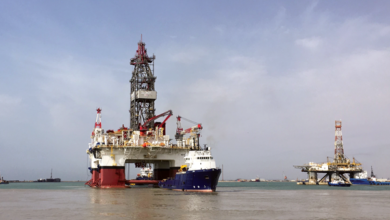Employing the three T’s — testing, timing and technology — can increase equipment reliability through maintenance strategies
Well-planned equipment maintenance is critical for minimizing costs and downtime while upholding worker safety
By Jennifer Eckert, Ingersoll Rand Material Handling

The oil and gas industry constantly fluctuates based on producer capacity and end-user demand. Low oil prices have put companies in a challenging position wherein they have to balance production, equipment investments and operational decisions with changing market conditions. To respond effectively, companies must carefully manage their assets by minimizing costs and maximizing efficiencies, while upholding worker safety.
Effective maintenance strategies can pay huge dividends in the areas of worker safety, uptime and equipment costs. An effective maintenance program saves time and money by avoiding unnecessary equipment repairs and failures, while providing continuous and uninterrupted production uptime.
There are three primary approaches to maintaining equipment in the oil and gas environment:
• Reactive maintenance – maintenance that is conducted when a need develops or when a failure occurs;
• Planned maintenance – maintenance that follows the timeline suggested by the original equipment manufacturer (OEM) for routine care;
• Preventative maintenance – maintenance that includes utilizing historical operational data to anticipate when maintenance will be needed and conduct the maintenance before a problem occurs. More advanced, real-time data from remote monitoring devices and sensors can also be used.
Offshore rigs often must withstand harsh environments, including strong winds and corrosive salt water. Exposed hoist and winch systems are subject to corrosion and potential vibration damage from high winds, cold temperatures and continuous air moisture. With these factors in mind, maintenance is particularly important to ensure equipment on the rig is in good working condition. Worker safety, uptime and savvy asset management depend on it.
High-value material handling equipment, such as winches and hoists, require an effective maintenance program to keep equipment performing optimally, extend the equipment life and minimize equipment repair costs and unplanned downtime. Maintenance and service technicians can use testing, timing and technology to establish an effective maintenance strategy and implementation plan.
• Testing – Testing procedures can help prove that maintenance work is required, eliminating guesswork and demonstrating to management that planning downtime for maintenance is worth the investment.
• Timing – Timing can be used to the company’s advantage – around when maintenance is performed and how often.
• Technology – Emerging technologies such as remote monitoring tools will soon offer real-time information to notify the service team as to when services should be conducted.
Testing is the first step

The first step in the maintenance regimen is testing. Testing procedures run the gamut from visual inspection to testing the particulates in the equipment fluids to functional testing. A good maintenance testing program will maintain a record of test results and actions taken, captured digitally so that they can be compared and tracked. Tests are completed on varying schedules – daily, weekly, monthly, quarterly and annually.
Visual inspections are the baseline level of testing and should be conducted annually by a trained and authorized service provider. Visual inspections are valuable in helping to identify structural issues, particularly in environments where the effects of weather and the conditions show wear and tear. For instance, on offshore rigs, visual inspections can quickly identify rust or salt build-up, cracks or contortions in support structures and leaks. While a visual inspection is helpful for identifying common, high-priority maintenance requirements, further analysis is required to identify internal wear. For these scenarios, diagnostic testing should be considered.
Diagnostic testing using fluids and other indicators on the equipment is another testing method that can provide valuable information. For example, a technician can take a sampling of oil from an equipment motor to test the particulates. Rust particulates in the oil can be an indicator that the motor is starting to experience rusting, which can be a flag that the equipment is starting to age at a quicker pace.
In that scenario, the equipment should be put on a more frequent maintenance and inspection schedule. This kind of testing is already quite common for critical drilling equipment. As equipment design evolves and digital control mechanisms become more affordable, it’s expected that such testing will become more accessible and relevant to less critical equipment on the rig. As the use of diagnostics increases, the market will be able to move from its dependence on reactive maintenance into planned and predictive maintenance.
Use timing as an ally
The factors that govern the timing of maintenance for material handling equipment will vary based on the equipment type, the frequency of equipment use, the rig location and site conditions. One guidepost to start with is the OEM-recommended maintenance and inspection schedule. This is a standard schedule provided with all equipment. For instance, Figure 1 represents the cadence of maintenance and inspections recommended for Dedicated Man Rider winches. The schedule includes suggested timing for repair, replacement, service and overhaul for a unit. Yet, it’s also important for operator and technicians to be aware of the applicable laws, regulations or regional practices where they are operating the equipment and defer to the schedule that is more stringent.
Although an OEM schedule is a great starting point, it doesn’t take into account how often the piece of equipment is used, the environmental factors in which it is operated or any other unique variables. Hoists and winches that are operated in harsh, dirty or corrosive environments will likely need more frequent and thorough inspections and maintenance, as well as equipment that is in round-the-clock use.
Another way to leverage timing is to be strategic about when to conduct planned maintenance and inspections. Take a frequently moving land rig, for example. It may operate in one location for only a month before it is moved. Rigging down typically takes three days of planned downtime – this is an excellent opportunity to run operational tests before the rig is disassembled and conduct inspections of specific parts and equipment as it’s dissembled. More invasive, offsite maintenance, which is done in partnership the OEM or an authorized service representative, should also be scheduled during these windows.
In the offshore context, it takes a lot of resources to fly in special service technicians to remote rig locations. Visits from out-sourced technicians should be timed with daily, scheduled downtime. There should also be a well-stocked selection of consumable wear parts and other common replacement parts on hand before the technician arrives. Visits can also be aligned with the timing of the OEM’s suggested service schedule to make sure each moment of planned downtime is optimized for maintenance.
Lastly, remember that the more time that has passed, the more necessary maintenance becomes. Always lean toward the approach of “early and often.” Allowing equipment to fall behind its maintenance schedule can put employees at undue risk and can quickly offset any perceived time savings with unexpected downtime.
The future of enhanced, preventive maintenance
Today, most oil and gas equipment operators are functioning in the reactive and planned maintenance modes, with critical drilling operations taking small steps toward preventive maintenance. Yet, all kinds of operations will benefit from advances in equipment design, enhanced controls and digital/remote monitoring.
For example, as material-handling equipment becomes more integrated into the internet of things (IoT), it will be able to monitor and alert personnel to potential problems before they become failures. As data and analytics about equipment is collected, they become more valuable assets with increased reliability and actionable intelligence. This powerful capability will drive oil and gas companies to achieve greater agility and efficiency and optimize their equipment investments, while continuing to uphold the safety of their employees.
True preventive maintenance strategies require data that indicate trends and then forecast and plan when maintenance will be required. Performance data is the only way operators can truly know when maintenance is required. Sometimes that might be shorter or longer than the OEM time-based schedule. It also supports accurate budgeting and planning and prevents unnecessary equipment overhauls and costly repairs. Because data can more accurately show whether equipment needs maintenance, it can potentially extend the equipment’s overall life. It also reduces the frequency of unanticipated failures that can lead to after-hours service calls, immediate response times and rush parts orders.
IoT and machine learning technologies will bring new intelligence to material-handling equipment that will enhance productivity and reduce maintenance costs. Rig operators will be better equipped to react to operational stresses and minimize failures, while improving uptime. Testing, timing and technology are business processes that support risk mitigation for worker safety, production efficiency and costs. Oil and gas companies that use these approaches can gain an advantage by focusing on continually improving and extending the life of their equipment and, thus, their operations. DC
This article is based on a presentation at the 2017 IADC Asset Integrity and Reliability Conference, 22-23 August, Houston.



